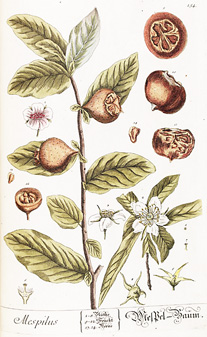Medieval Medlar
By Audrey Stallsmith

I'll graff it with you, and then I shall graff it with a medlar: then it will be the earliest fruit i' the country; for you'll be rotten ere you be half ripe, and that's the right virtue of the medlar.
William Shakespeare, As You Like It
Now that the quince I grew from seed is finally producing some fruit, maybe it’s time to find another weird fruit tree to add to my collection! I have sown medlar a couple times with, so far, no germination. So I may have to break down and buy this medieval tree instead.
Actually, Mespilus germanicus was ancient even during the medieval period and dates to before Christ, but we authors must have our alliteration! As with quince, its fruit has to be bletted (softened) by either frost or aging before it sweetens enough to be consumed. In other words, it isn’t ripe until it’s virtually rotten! But, when finally mature, it is supposed to taste like a spicy and winey apple custard. In merry old England, the fruits were often passed around with the port after dinner.
The small tree is attractive as well, with long, tropical-looking leaves and white blossoms which appear at the tips of the branches in the centers of leaf-whorls. The medlar can actually set fruits without pollination, so it may come in handy if the honeybee decline continues.
Those fruits look like large and leathery rose hips, and turn a wrinkled dark brown when aged, after which the soft pulp can be sucked or scooped out of the shell. “So brown and soft and coming suave,” as D. H. Lawrence writes in “Fruit Poem: Medlars and Sorb Apples.” “So morbid, as the Italians say./ What a rare, powerful, reminiscent flavour/ Comes out of your falling through the stages of decay. . .The exquisite odour of leave-taking.”
The fruit has a shallow depression beneath its sepals, sometimes called an eye, but often made the “butt” of jokes in authors such as Shakespeare. The fact that the astringent leaves were often used to treat piles (hemorrhoids) probably didn’t help!
The medlar was also used as a metaphor for aging, perhaps because it begins to look twisted and gnarly while still young. Geoffrey Chaucer writes in the “Prologue to The Reeve’s Tale” that “my heart, too, is as mouldy as my hairs,/ Unless I fare like medlar, all perverse,/ For that fruit’s never ripe until it’s worse. . .”
Interestingly enough, the only other species of Mespilus ever discovered, the bushier Mespilus canescens or Stern's Medlar, was found in Arkansas during the very modern 1990’s. Since there were originally only 20-some of the shrubs in existence, the plant is considered endangered. Some people believe it may actually be a cross between Mespilus germanica and a type of hawthorn once common in that area, rather than an original species. The fact that its flowers are unpleasantly scented like hawthorn's, while the true medlar's are odorless, may indicate that.
Since medlar is one of those fruits that people either love or hate, it's probably best to try it before you buy it. Assuming, of course, that you can actually find medlar fruits for sale in the U. S. If nothing else, this tree reassures us that time and hardship may make us sweeter--though getting to that point before decay sets in could be tricky!
Mespilus germanica image is from Herbarium Blackwellianum by Elisabeth Blackwell, courtesy of the Missouri Botanical Garden.








